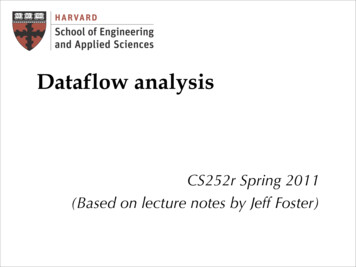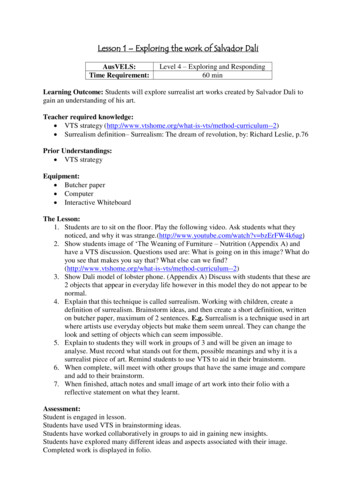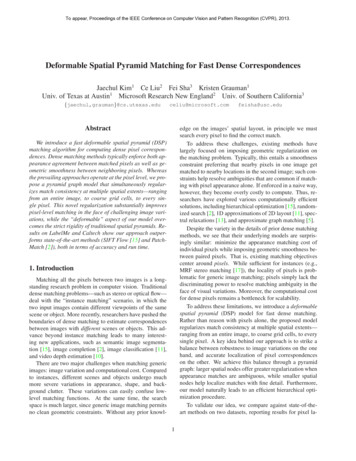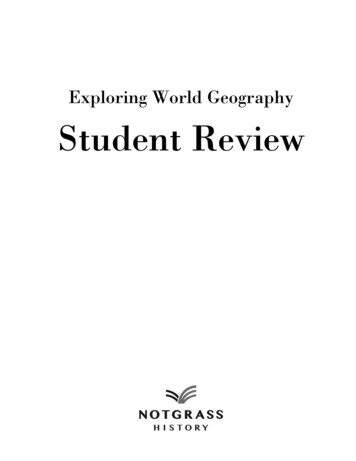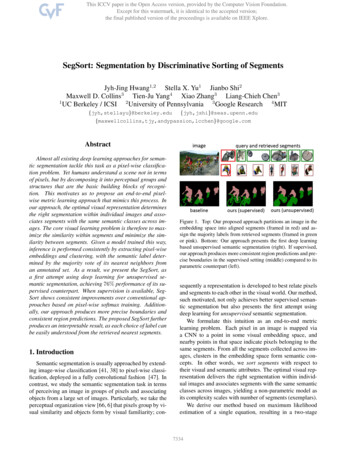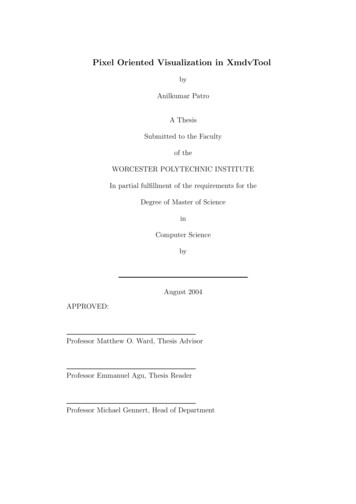Transcription
Propagate Yourself: Exploring Pixel-Level Consistency for Unsupervised VisualRepresentation LearningZhenda Xie*13 , Yutong Lin 23 , Zheng Zhang3 , Yue Cao3 , Stephen Lin3 , Han Hu31Tsinghua University 2 Xi’an Jiaotong University3Microsoft Research stractContrastive learning methods for unsupervised visualrepresentation learning have reached remarkable levels oftransfer performance. We argue that the power of contrastive learning has yet to be fully unleashed, as currentmethods are trained only on instance-level pretext tasks,leading to representations that may be sub-optimal fordownstream tasks requiring dense pixel predictions. In thispaper, we introduce pixel-level pretext tasks for learningdense feature representations. The first task directly applies contrastive learning at the pixel level. We additionally propose a pixel-to-propagation consistency task thatproduces better results, even surpassing the state-of-the-artapproaches by a large margin. Specifically, it achieves 60.2AP, 41.4 / 40.5 mAP and 77.2 mIoU when transferred toPascal VOC object detection (C4), COCO object detection(FPN / C4) and Cityscapes semantic segmentation using aResNet-50 backbone network, which are 2.6 AP, 0.8 / 1.0mAP and 1.0 mIoU better than the previous best methodsbuilt on instance-level contrastive learning. Moreover, thepixel-level pretext tasks are found to be effective for pretraining not only regular backbone networks but also headnetworks used for dense downstream tasks, and are complementary to instance-level contrastive methods. Theseresults demonstrate the strong potential of defining pretexttasks at the pixel level, and suggest a new path forward inunsupervised visual representation learning. Code is available at https://github.com/zdaxie/PixPro.1. IntroductionAccording to Yann LeCun, “if intelligence is a cake,the bulk of the cake is unsupervised learning”. This quotereflects his belief that human understanding of the world* Equal Contribution. The work is done when Zhenda Xie and YutongLin are interns at Microsoft Research Asia.view #1consistencyview #2Figure 1. An illustration of the proposed PixPro method, which isbased on a pixel-to-propagation consistency pretext task for pixellevel visual representation learning. In this method, two views arerandomly cropped from an image (outlined in black), and the features from the corresponding pixels of the two views are encouraged to be consistent. For one of them, the feature comes froma regular pixel representation (illustrated as orange crosses). Theother feature comes from a smoothed pixel representation (shownas green dots) built by propagating the features of similar pixels(illustrated as the light green region). Note that this hard selection of similar pixels is for illustration only. In implementation, allpixels on the same view will contribute to propagation, with thepropagation weight of each pixel determined by its feature similarity to the center pixel.is predominantly learned from the tremendous amount ofunlabeled information within it. Research in machine intelligence has increasingly moved in this direction, withsubstantial progress in unsupervised and self-supervisedlearning[34, 18, 25, 8, 30]. In computer vision, recent advances can largely be ascribed to the use of a pretext taskcalled instance discrimination, which treats each image ina training set as a single class and aims to learn a featurerepresentation that discriminates among all the classes.Although self-supervised learning has proven to be remarkably successful, we argue that there remains significant116684
untapped potential. The self-supervision that guides representation learning in current methods is based on imagelevel comparisons. As a result, the pre-trained representation may be well-suited for image-level inference, suchas image classification, but may lack the spatial sensitivityneeded for downstream tasks that require pixel-level predictions, e.g., object detection and semantic segmentation.How to perform self-supervised representation learning atthe pixel level is a problem that until now has been relatively unexplored.In this paper, we tackle this problem by introducingpixel-level pretext tasks for self-supervised visual representation learning. Inspired by recent instance discrimination methods, our first attempt is to construct a pixel-levelcontrastive learning task, where each pixel in an image istreated as a single class and the goal is to distinguish eachpixel from others within the image. Features from the samepixel are extracted via two random image crops containingthe pixel, and these features are used to form positive training pairs. On the other hand, features obtained from different pixels are treated as negative pairs. With training datacollected in this self-supervised manner, a contrastive lossis applied to learn the representation. We refer to this approach as PixContrast.In addition to this contrastive approach, we present amethod based on pixel-to-propagation consistency, wherepositive pairs are obtained by extracting features from thesame pixel through two asymmetric pipelines instead. Thefirst pipeline is a standard backbone network with a projection head. The other has a similar form but ends with aproposed pixel propagation module, which filters the pixel’sfeatures by propagating the features of similar pixels to it.This filtering introduces a certain smoothing effect, whilethe standard feature maintains spatial sensitivity. A difference of this method from the contrastive approach of PixContrast is that it encourages consistency between positivepairs without consideration of negative pairs. While the performance of contrastive learning is known to be influencedheavily by how negative pairs are handled [18, 8], this issue is avoided in this consistency-based pretext task. Empirically, we find that this pixel-to-propagation consistencymethod, which we call PixPro, significantly outperformsthe PixContrast approach over various downstream tasks.Besides learning good pixel-level representations, theproposed pixel-level pretext tasks are found to be effectivefor pre-training on not only backbone networks but alsohead networks used for dense downstream tasks, contraryto instance-level discrimination where only backbone networks are pre-trained and transferred. This is especiallybeneficial for downstream tasks with limited annotated data,as all layers can be well-initialized. Moreover, the proposedpixel-level approach is complementary to existing instancelevel methods, where the former is good at learning a spa-tially sensitive representation and the latter provides bettercategorization ability. A combination of the two methodscapitalizes on both of their strengths, while also remainingcomputationally efficient in pre-training as they both canshare a data loader and backbone encoders.The proposed PixPro achieves state-of-the-art transferperformance on common downstream benchmarks requiring dense prediction. Specifically, with a ResNet-50 backbone, it obtains 60.2 AP on Pascal VOC object detection using a Faster R-CNN detector (C4 version), 41.4 / 40.5 mAPon COCO object detection using a Mask R-CNN detector(both the FPN / C4 versions, 1 settings), and 77.2 mIoUCityscapes semantic segmentation using an FCN method,which are 2.6 AP, 0.8 / 1.0 mAP, and 1.0 mIoU better thanthe leading unsupervised/supervised methods. Though pastevaluations of unsupervised representation learning havemostly been biased towards linear classification on ImageNet, we advocate a shift in attention to performance ondownstream tasks, which is the main purpose of unsupervised representation learning and a promising setting forpixel-level approaches.2. Related WorksInstance discrimination Unsupervised visual representation learning is currently dominated by the pretext task ofinstance discrimination, which treats each image as a single class and learns representations by distinguishing eachimage from all the others. This line of investigation canbe traced back to [14], and after years of progress [34, 29,21, 38, 1, 35], transfer performance superior to supervisedmethods was achieved by MoCo [18] on a broad range ofdownstream tasks. After this milestone, considerable attention has been focused in this direction [8, 30, 3, 17, 5].While follow-up works have quickly improved the linearevaluation accuracy (top-1) on ImageNet-1K from about60% [18] to higher than 75% [5] using a ResNet-50 backbone, the improvements on downstream tasks such as objectdetection on Pascal VOC and COCO have been marginal.Instead of using instance-level pretext tasks, our workexplores pretext tasks at the pixel level for unsupervised feature learning. We focus on transfer performance to downstream tasks such as object detection and semantic segmentation, which have received limited consideration in priorresearch. We show that pixel-level representation learningcan surpass the existing instance-level methods by a significant margin, demonstrating the potential of this direction.Other pretext tasks using a single image Aside from instance discrimination, there exist numerous other pretexttasks including context prediction [13], grayscale imagecolorization [36], jigsaw puzzle solving [26], split-brainauto-encoding [37], rotation prediction [16], learning to126685
cluster [4], and missing part prediction [21, 32, 7]. Interest in these tasks for unsupervised feature learning hasfallen off considerably due to their inferior performance andgreater complexity in architectures or training strategies.Among these methods, the approach most related to oursis missing parts prediction [21, 32, 7], which was inspiredby successful pretext tasks in natural language processing [12, 2]. Like our pixel-propagation consistency technique, such methods also operate locally. However, theyeither partition images into patches [32, 21] or require special architectures/training strategies to perform well [21, 7],while our approach directly operates on pixels and has nospecial requirements on the encoding networks. Trainingwith our method is also simple, with few bells and whistles. More importantly, our approach achieves state-of-theart transfer performance on the important dense predictiontasks of object detection and semantic segmentation.3. Methodtween all pairs of pixels from the two feature maps arecomputed. The distances are normalized to the diagonallength of a feature map bin to account for differences inscale between the augmentation views, and the normalizeddistances are used to generate positive and negative pairs,based on a threshold T :(1, if dist(i, j) T ,(1)A(i, j) 0, if dist(i, j) T ,where i and j are pixels from each of the two views;dist(i, j) denotes the normalized distance between pixel iand j in the original image space; and the threshold is set toT 0.7 by default.Similar to instance-level contrastive learning methods,we adopt a contrastive loss for representation learning:PLPix (i) log Pj Ωip3.1. Pixel-level Contrastive LearningThe state-of-the-art unsupervised representation learningmethods are all built on the pretext task of instance discrimination. In this section, we show that the idea of instance discrimination can be also applied at the pixel level for learningvisual representations that generalize well to downstreamtasks. We adopt the prevalent contrastive loss to instantiate the pixel-level discrimination task, and call this methodPixContrast.As done in most instance-level contrastive learningmethods, PixContrast starts by sampling two augmentationviews from the same image. The two views are both resized to a fixed resolution (e.g., 224 224) and are passedthrough a regular encoder network and a momentum encoder network [18, 9, 17] to compute image features. Theencoder networks are composed of a backbone network anda projection head network, where the former could be anyimage neural network (we adopt ResNet by default), andthe latter consists of two successive 1 1 convolution layers (of 2048 and 256 output channels, respectively) witha batch normalization layer and a ReLU layer in-betweento produce image feature maps of a certain spatial resolution, e.g., 7 7. While previous methods compute a singleimage feature vector for each augmentation view, PixContrast computes a feature map upon which pixel-level pretexttasks can be applied. The learnt backbone representationsare then used for feature transfer. An illustration of the architecture is shown in Figure 2.Pixel Contrast With the two feature maps computed fromtwo views, we can construct pixel contrast pretext tasks forrepresentation learning. Each pixel in a feature map is firstwarped to the original image space, and the distances be-ecos(xi ,xj )/τj Ωipecos(xi ,xj )/τ ′′Pecos(xi ,xk )/τ′, (2)k Ωinwhere i is a pixel in the first view that is also located in thesecond view; Ωip and Ωin are sets of pixels in the secondview assigned as positive and negative, respectively, withrespect to pixel i; xi and x′j are the pixel feature vectors intwo views; and τ is a scalar temperature hyper-parameter,set by default to 0.3. The loss is averaged over all pixels onthe first view that lie in the intersection of the two views.Similarly, the contrastive loss for a pixel j on the secondview is also computed and averaged. The final loss is theaverage over all image pairs in a mini-batch.As later shown in the experiments, this direct extensionof instance-level contrastive learning to the pixel level performs well in representation learning.3.2. Pixel-to-Propagation ConsistencyThe spatial sensitivity and spatial smoothness of a learntrepresentation may affect transfer performance on downstream tasks requiring dense prediction. The former measures the ability to discriminate spatially close pixels,needed for accurate prediction in boundary areas where labels change. The latter property encourages spatially closepixels to be similar, which can aid prediction in areas thatbelong to the same label. The PixContrast method described in the last subsection only encourages the learnt representation to be spatially sensitive. In the following, wepresent a new pixel-level pretext task which additionally introduces spatial smoothness in the representation learning.This new pretext task involves two critical components.The first is a pixel propagation module, which filters apixel’s features by propagating the features of similar pixelsto it. This propagation has a feature denoising/smoothingeffect on the learned representation that leads to more coherent solutions among pixels in pixel-level prediction tasks.316686
view#1inputPixel-to-PropagationModule (PPM)backbone projectionaugmentationPixContrast Loss (Eq. 2)view#2PixPro Loss (Eq. 5)momentumbackbone projectionFigure 2. Architecture of the PixContrast and PixPro methods.The second component is an asymmetric architecture design where one branch produces a regular feature map andthe other branch incorporates the pixel-propagation module. The pretext task seeks consistency between the featuresfrom the two branches without considering negative pairs.On the one hand, this design maintains the spatial sensitivity of the learnt representation to some extent, thanks to theregular branch. On the other hand, while the performanceof contrastive learning is known to be heavily affected bythe treatment of negative pairs [18, 8], the asymmetric design enables the representation learning to rely only on consistency between positive pairs, without facing the issue ofcarefully tuning negative pairs [17]. We refer to this pretext task as pixel-to-propagation consistency (PPC) and describe these primary components in the following.Pixel Propagation Module For each pixel feature xi , thepixel propagation module computes its smoothed transformyi by propagating features from all pixels xj within thesame image Ω asyi Σj Ω s(xi , xj ) · g(xj ),CxHxWHWxCsimilarity computations(*,*)HWxCγs(xi , xj ) (max(cos(xi , xj ), 0)) ,(4)with γ being an exponent to control the sharpness of thesimilarity function and is set by default to 2; g(·) is a transformation function that can be instantiated by l linear layerswith a batch normalization and a ReLU layer between twosuccessive layers. When l 0, g(·) is an identity functionand Eq. (3) will be a non-parametric module. Empirically,we find that all of l {0, 1, 2} perform well, and we setl 1 by default as its results are slightly better. Figure 3illustrates the proposed pixel propagation module.Pixel-to-Propagation Consistency Loss In the asymmetric architecture design, there are two different encoders: aregular encoder with the pixel propagation module appliedafterwards to produce smoothed features, and a momentumencoder without the propagation module. The two augmentation views both pass through the two encoders, and theCxHWtransformg(*)CxHxWCxHxWFigure 3. Illustration of the pixel propagation module (PPM). Theinput and output resolutions of each computation block are included.features from different encoders are encouraged to be consistent:(3)where s(·, ·) is a similarity function defined asHWxCCxHxWHWxHWLPixPro cos(yi , x′j ) cos(yj , x′i ),(5)where i and j are a positive pixel pair from two augmentation views according to the assignment rule in Eq. (1); x′iand yi are pixel feature vectors of the momentum encoderand the propagation encoder, respectively. This loss is averaged over all positive pairs for each image, and then furtheraveraged over images in a mini-batch to drive the representation learning.Comparison to PixContrast The overall architecture ofthe pixel-to-propagation consistency (PPC) method is illustrated in Figure 2. Compared to the PixContrast method described in Section 3.1 (see the blue-color loss in Figure 2),there are two differences: the introduction of a pixel propagation module (PPM), and replacement of the contrastiveloss by a consistency loss. Table 2(c) and 3 show that bothchanges are critical for the feature transfer performance.Computation complexity The proposed PixContrast andPixPro approaches adopt the same data loader and back146687
bone architectures as those of the instance discriminationbased representation learning methods. There computation complexity in pre-training is thus similar as that of thecounterpart instance-level method (i.e. BYOL [17]): 8.6Gvs. 8.2G FLOPs using a ResNet-50 backbone architecture,where the head and loss contribute about 0.4G FLOPs overhead.lar instance-level method, SimCLR [8], with a momentumencoder to be aligned with the pixel-level pretext task. Inthis combination, the two losses from the pixel-level andinstance-level pretext tasks are balanced by a multiplicativefactor α (set to 1 by default), as3.3. Aligning Pre-training to Downstream NetworksIn general, the two tasks are complementary to eachother: a pixel-level pretext task learns representations goodfor spatial inference, while an instance-level pretext task isgood for learning categorization representations. Table 4shows that an additional instance-level contrastive loss cansignificantly improve ImageNet-1K linear evaluation, indicating that a better categorization representation is learnt.Likely because of better categorization ability, it achievesnoticeably improved transfer accuracy on the downstreamtask of FCOS [31] object detection on COCO (about 1 mAPimprovement).Previous visual feature pre-training methods are generally limited to classification backbones. For supervised pretraining, i.e. by the ImageNet image classification pretexttask, the standard practice is to transfer only the pre-trainedbackbone features to downstream tasks. The recent unsupervised pre-training methods have continued this practice.One reason is that the pre-training methods operate at theinstance level, making them less compatible with the denseprediction required in head networks for downstream tasks.In contrast, the fine-grained spatial inference of pixellevel pretext tasks more naturally aligns with dense downstream tasks. To examine this, we consider an object detection method, FCOS [31], for dense COCO detection.FCOS [31] applies a feature pyramid network (FPN) fromP3 (8 down-sampling) to P7 (128 down-sampling) [22],followed by two separate convolutional head networks(shared for all pyramidal levels) on the output feature mapsof a ResNet backbone to produce classification and regression results.We adopt the same architecture from the input image until the third 3 3 convolutional layer in the head. In FPN,we involve feature maps from P3 to P6, with P7 omitted because the resolution is too low. A pixel propagation module(PPM) with shared weights and the pixel-to-propagationconsistency (PPC) loss described in Section 3.2 are appliedon each pyramid level. The final loss is first averaged ateach pyramidal level and then averaged over all the pyramids.Pre-training the FPN layers and the head networks usedfor downstream tasks can generally improve the transfer accuracy, as shown in Tables 5 and 6.3.4. Combined with Instance ContrastThe presented pixel-level pretext tasks adopt the samedata loader and encoders as in state-of-the-art instance-leveldiscrimination methods [18, 17], with two augmentationviews sampled from each image and fed into backbone encoders. Hence, our pixel-level methods can be convenientlycombined with instance-level pretext tasks, by sharing thesame data loader and backbone encoders, with little pretraining overhead.Specifically, the instance-level pretext task is applied onthe output of the res5 stage, using projection heads that areindependent of the pixel-level task. Here, we use a popu-L LPixPro αLinst .(6)4. Experiments4.1. Pre-training SettingsDatasets We adopt the widely used ImageNet-1K [11]dataset for feature pre-training, which consists of 1.28million training images.Architectures Following recent unsupervised methods [18, 17], we adopt the ResNet-50 [20] model asour backbone network. The two branches use differentencoders, with one using a regular backbone network and aregular projection head, and the other using the momentumnetwork with a moving average of the parameters of theregular backbone network and the projection head. Theproposed pixel propagation module (PPM) is applied onthe regular branch.The FPN architecture with P3-P6 featuremaps are also tested in some experiments.Data Augmentation In pre-training, the data augmentation strategy follows [17], where two random crops from theimage are independently sampled and resized to 224 224with a random horizontal flip, followed by color distortion,Gaussian blur, and a solarization operation. We skip theloss computation for cropped pairs with no overlaps, whichcompose only a small fraction of all the cropped pairs.Optimization We vary the training length from 50 to 400epochs, and use 100-epoch training in our ablation study.The LARS optimizer with a cosine learning rate schedulerand a base learning rate of 1.0 is adopted in training, wherethe learning rate is linearly scaled with the batch size aslr lrbase #bs/256. Weight decay is set to 1e-5. Thetotal batch size is set to 1024, using 8 V100 GPUs. For the516688
MethodscratchsupervisedMoCo [18]SimCLR [8]MoCo v2 [9]InfoMin [30]InfoMin [30]PixPro (ours)PixPro (ours)#. Epoch1002001000800200800100400Pascal VOC (R50-C4)AP AP50AP7533.8 60.233.153.5 81.358.855.9 81.562.656.3 81.962.557.6 82.764.457.6 82.764.657.5 82.564.058.8 83.066.560.2 83.867.7COCO (R50-FPN)mAP AP50 AP7532.8 51.0 35.339.7 59.5 43.339.4 59.1 43.039.8 59.5 43.640.4 60.1 44.340.6 60.6 44.640.4 60.4 44.341.3 61.3 45.441.4 61.6 45.4COCO (R50-C4)mAP AP50 AP7526.4 44.0 27.838.2 58.2 41.238.5 58.3 41.638.4 58.3 41.639.5 59.0 42.639.0 58.5 42.038.8 58.2 41.740.0 59.3 43.440.5 59.8 44.0Cityscapes (R50)mIoU65.374.675.375.876.275.675.676.877.2Table 1. Comparing the proposed pixel-level pre-training method, PixPro, to previous supervised/unsupervised pre-training methods. ForPascal VOC object detection, a Faster R-CNN (R50-C4) detector is adopted for all methods. For COCO object detection, a Mask R-CNNdetector (R50-FPN and R50-C4) with 1 setting is adopted for all methods. For Cityscapes semantic segmentation, an FCN method (R50)is used. Only a pixel-level pretext task is involved in PixPro pre-training. For Pascal VOC (R50-C4), COCO (R50-C4) and Cityscapes(R50), a regular backbone network of R50 with output feature map of C5 is adopted for PixPro pre-training. For COCO (R50-FPN), anFPN network with P3 -P6 feature maps is used. Note that InfoMin [30] reports results for only its 200 epoch model, so we reproduce itwith longer training lengths, where saturation is observed.momentum encoder, the momentum value starts from 0.99and is increased to 1, following [17]. Synchronized batchnormalization is enabled during training.4.2. Downstream Tasks and SettingsWe evaluate feature transfer performance on four downstream tasks: object detection on Pascal VOC [15], object detection on COCO [23], semantic segmentation onCityscapes [10], and semi-supervised object detection onCOCO [28]. In some experiments, we also report theImageNet-1K [11] linear evaluation performance for reference.Pascal VOC Object Detection We strictly follow the setting introduced in [18], namely a Faster R-CNN detector [27] with the ResNet50-C4 backbone, which uses theconv4 feature map to produce object proposals and uses theconv5 stage for proposal classification and regression. Infine-tuning, we synchronize all batch normalization layersand optimize all layers. In testing, we report AP, AP50 andAP75 on the test2007 set. Detectron2 [33] is used as thecode base.follow the 1 settings and utilize the mmdetection codebase [6].Cityscapes Semantic Segmentation We follow the settings of MoCo [18], where an FCN-based structure isused [24]. The FCN network consists of a ResNet-50 backbone with 3 3 convolution layers in the conv5 stage ofdilation 2 and stride 1, followed by two 3 3 convolutionlayers of 256 channels and dilation 6. The classification isobtained by an additional 1 1 convolutional layer.Semi-Supervised Object Detection We also examinedsemi-supervised learning for object detection on COCO.For this, a small fraction (1%-10%) of images randomlysampled from the training set is assigned labels and used infine-tuning. The results of five random trials are averagedfor each method.ImageNet-1K Linear Evaluation In this task, we fix thepretrained features and only fine-tune one additional linear classification layer, exactly following the settings ofMoCo [18]. We report these results for reference.4.3. Main Transfer ResultsCOCO Object Detection and Instance SegmentationWe adopt the Mask R-CNN detector with ResNet50-FPNand ResNet50-C4 [19, 22] backbones, respectively. In optimization, we follow the 1 settings, with all batch normalization layers synchronized and all layers fine-tuned [18].We adopt Detectron2 [33] as the code base for these experiments.We also consider other detectors with fully convolutionalarchitectures, e.g., FCOS [31]. For these experiments, weTable 1 compares the proposed method to previous stateof-the-art unsupervised pre-training approaches on 4 downstream tasks, which all require dense prediction. Our PixPro achieves 60.2 AP, 41.4 / 40.5 mAP and 77.2 mIoU onPascal VOC object detection (R50-C4), COCO object detection (R50-FPN / R50-C4) and Cityscapes semantic segmentation (R50). It outperforms the previous best unsupervised methods by 2.6 AP on Pascal VOC, 0.8 / 1.0 mAP onCOCO and 1.0 mIoU on Cityscapes.616689
Pascal VOC COCOAP AP50 AP70 mAP(a) dist. threshold T using C5T 0.35 58.3 82.1 65.8 39.5T 0.7 58.8 83.0 66.5 40.8T 1.4 56.8 82.0 63.3 39.5T 2.8 56.5 81.7 63.4 39.1(b) dist. threshold T using P3T 0.35 58.1 83.0 64.7 40.8T 0.7 57.6 83.0 63.6 40.8T 1.4 56.8 82.7 63.1 40.6T 2.8 56.1 82.4 64.7 40.2(c) sharpness exponent γγ 0.5 57.9 82.5 64.5 39.758.7 83.0 65.5 40.1γ 158.8 83.0 66.5 40.8γ 2 γ 458.0 82.4 64.7 40.0hyp. par.Pascal VOCAP AP50 AP70(d) layer number in g(·)l 058.6 82.9 65.4l 1 58.8 83.0 66.5l 258.9 83.1 66.3l 358.3 82.5 65.0(e) output resolutionC5 (72 ) 58.8 83.0 66.5P4 (142 ) 56.7 82.7 63.6P3 (282 ) 57.6 83.0 63.6P3 -P655.8 82.5 62.1(f) training length50 ep57.2 82.4 63.4100 ep 58.8 83.0 66.5200 ep 59.5 83.5 66.9400 ep 60.2 83.8 67.7hyp. .940.841.3PixPro39.740.840.841.0Table 2. Ablation studies on hyper-parameters for the proposedPixPro method. Rows with indicate default values.4.4. Ablation StudyWe conduct the ablation study using the Pascal VOC(R50-C4) and COCO object detection (R50-FPN) tasks.In some experiments, the results of the FCOS detector onCOCO and semi-supervised results are included.Hyper-Parameters for PixPro Table 2 examines the sensitivity to hyper-parameters of PixPro. For the ablation ofeach hyper-parameter, we fix all other hyper-parameters tothe following default values: feature map of C5 , distancethreshold T 0.7, sharpness exponent γ 2, numberof transformation layers in the pixel-to-propagation modulel 1, and training length of 100 epochs.Table 2 (a-b) ablates distance thresholds using the feature maps of C5 and P3 . For both, T 0.7 yields goodperformance. The results are more stable for P3 , thanks toits larger resolution.Table 2 (c) ablates the sharpness exponent γ, where γ 2 shows the best results. A similarity function that is toosmooth or too sharp harms transfer performance.Table 2 (d) ablates the number of transformation layersin g(·), where l 1 shows slightly better performance thanothers. Note that l 0, which has no learnable parameters in the pixel-propagation module (PPM), also performsreasonably well, while removal of the PPM module resultsin model collapse. The smoothness operation in the PPMmodule introduces asymmetry with respect to the other regular branch, and consequently avoids coll
the pixel level is a problem that until now has been rela-tively unexplored. In this paper, we tackle this problem by introducing pixel-level pretext tasks for self-supervised visual repre-sentation learning. Inspired by recent instance discrimina-tion methods, our first attempt is to construct a Cited by: 43Publish Year: 2021Author: Zhenda Xie, Yutong Lin, Zheng Zhang, Yue Cao, Stephen Lin, Han Hu


